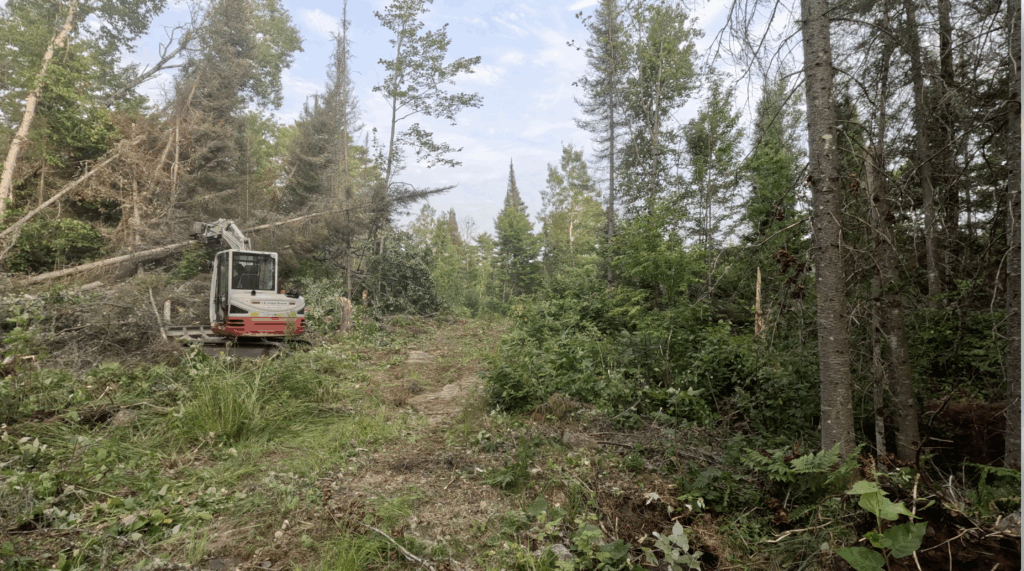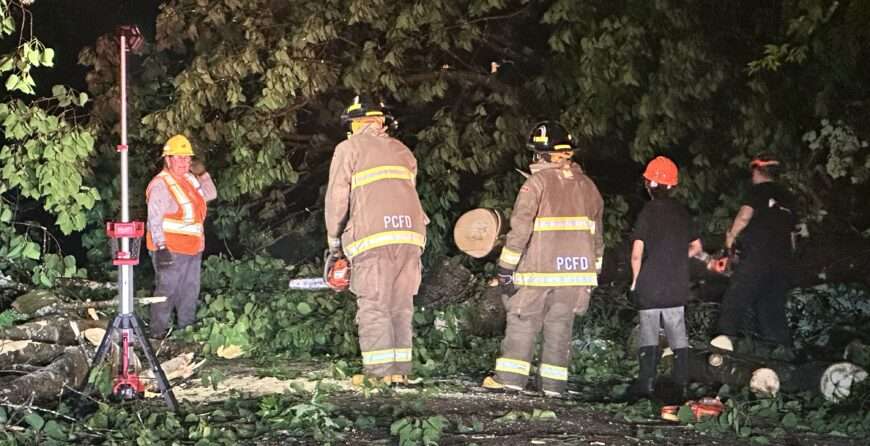Here in Northern Ontario, storms have a way of showing up fast and hitting hard. Fallen trees, blocked laneways, and storm debris are becoming more common with every season. And while it might be tempting to grab a chainsaw and handle the mess yourself, that decision can quickly turn dangerous.
Storm-damaged trees are unpredictable—sometimes deadly.
When a big tree comes down, it’s rarely just one problem. Often, it pulls or lands on other trees, bending them under pressure. These trees might look stable from the outside, but they’re under massive stress. They’re basically giant loaded springs. The second you cut in the wrong spot or disturb the wrong section—snap, that pressure releases, and now you’re dealing with a tree that just kicked back with the force of a battering ram.
We’ve seen people get seriously hurt trying to cut trees that were under tension—broken bones, sprains, concussions, and in some cases, far worse. This isn’t a backyard DIY job—it’s a dangerous situation if you don’t know exactly what you’re dealing with.
Immediately after that brutal storm hit Papineau-Cameron and Calvin, we were out doing emergency cleanup, and one thing became clear—even for those with experience, storm-damaged trees are a whole different beast. A lot of folks were already out trying to clear roads and clean up their properties, and while many know their way around a chainsaw, storm damage adds a new level of unpredictability. Trees were twisted, tangled, and under extreme pressure, especially where they’d come down on power lines or were leaning on other trees.
We’ve said this before and it’s worth repeating:
“Stay well clear of any leaning or damaged trees. If you come across a tree that has fallen onto power lines, do not approach it. Always assume the line is live and stay at least 10 metres (33 feet) away.”
Electricity can travel through the ground, and maintaining that distance is critical. Hydro One provides a great guide on how to stay safe around downed power lines.
Sometimes it’s hard to be fully aware of your surroundings—especially when it’s dark, wet, or you’re just trying to get through the mess. Just because the storm has passed doesn’t mean the danger is over.
Back in June, we showed up to the area within an hour of the storm hitting, and once we realized just how badly Mattawa River Resort had been affected, we got to work immediately. The access road was so thick with downed trees, you couldn’t even tell where the road was anymore. It was pitch black, and all around us you could hear trees cracking—not just a couple here and there, but constantly, for hours.
One of the things that stood out that night was just how integral the Papineau-Cameron Fire Department was in helping us get it done. They weren’t just there—they were right in the thick of it with us, chainsaws in hand, helping to move trees and keep the area safe while we worked. These guys showed up without hesitation and worked through one of the sketchiest, most dangerous storm cleanups we’ve seen in a while. No ego, no drama—just pure teamwork and community effort.
Every cut we made, we had to stop and listen. We couldn’t see what else might be ready to fall. That kind of job makes you respect the work and reminds you how quickly things can go wrong if you’re not cautious. Having the fire department there wasn’t just helpful—it was critical. We were proud to work alongside them.
That’s why we always tell people—don’t take chances after a storm.

At Canada Brush Control, we do this kind of work all the time. We don’t just show up with a saw and hope for the best. We assess the tree, check what it’s resting on, what’s around it, and what could go wrong before we even pull the cord.
We have the experience and equipment necessary to get the job done—safely, efficiently, and without cutting corners.
Every job is different, and storms have a way of creating situations you can’t always predict—but we show up prepared, work smart, and stay focused on getting your property safely cleared and accessible again.
We’re not here to talk politics, but it’s clear these storms aren’t letting up. Whether it’s spring, summer, or fall, every season now seems to bring another round of heavy wind and rain. The more this happens, the more important it is to be ready and know who to call.
So if you ever find yourself staring at a driveway blocked with trees, don’t risk it. Here’s what we recommend after a storm:
- Stay safe – Avoid walking under hanging limbs or around leaning trees.
- Inspect from a distance – Use your phone camera or binoculars to get a closer look without putting yourself at risk.
- Stay away from power lines – Assume every line is live. Keep a 10-metre (33 feet) distance—minimum.
- Don’t start cutting without knowing what you’re cutting into – Tension and pressure aren’t always visible.
- Call Canada Brush Control – We’ll handle it safely and efficiently, so you don’t have to.
For more general guidance on what to do after major storms, the Government of Canada also offers helpful storm recovery tips.
Need Help After a Storm?
Give us a call or visit our Storm Cleanup Services page to see how we can help.
We’re fast, professional, and ready when the storm ends—and when safety matters most.


